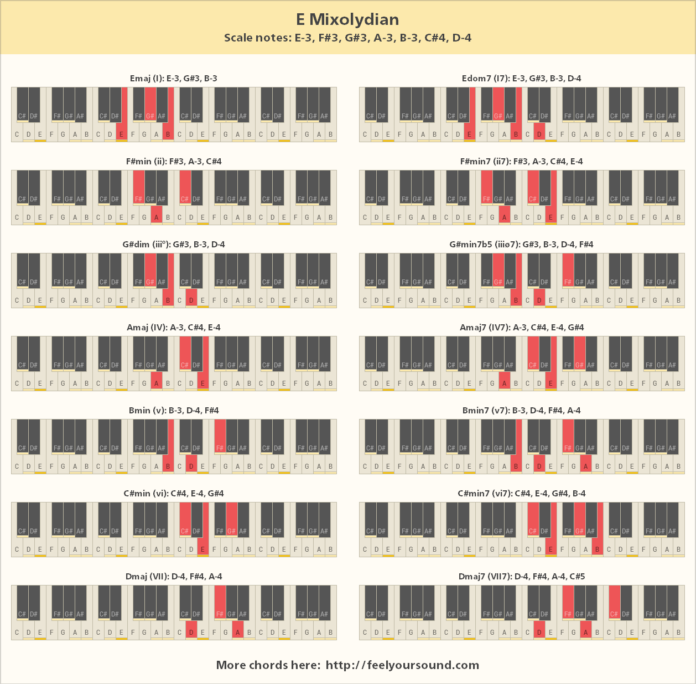Introduction:
The Mixolydian function is awe-inspiring. This musical mode serves as the foundation for a number of other mixolydian chord progression genres and can convey intense emotions. The possibilities are almost endless. However, how can you compose Mixolydian chordal structures or melodies? Let us find out and get creative. The Mixolydian mode has been adopted by rock musicians, film composers, jazz performers, and singer-songwriters. And with a lot of success. As you can see from my examples, the music may be as strong or as gentle and intimate according to what you wish. But what exactly is the Mixolydian mode, and how can you begin producing music in it.
Make Mixolydian Movements and Melodies in this Video Tutorial:
If you want to interact with all of these samples with real music, see my Mixolydian mode video. It includes samples from rock to traditional music. I swear it will not let you down.
Modes simplified: Many people consider musical modes to be parts of a larger mode as parent scale known as the Ionian mode. But I refrain from approaching it this way 90% of the time. I like to think of each mode as its own scale. As a result, it is not a part of something larger. Mixolydian reflects what it is, not some minor scale’s younger brother. I’ll show you how to create a Mixolydian scale plus chord progression.
How to Compose Music in Mixolydian Mode:
- In a major scale, reduce the 7th note by half a step.
- For each scale degree, compose a chord/triad.
- Concentrate your chords plus melody in the lowered 7th scale degree, its core, and major 3rd.
How does one create a Mixolydian scale:
When we discuss art being in a specific key. We genuinely mean the notes that belong to or could be employed in our song. And these notes, more often than not, create a scale. To begin our adventure, we must first create a scale and determine the Mixolydian modes formula.
Major Scale:
To begin, we must create a large size. you may be wondering. Yes, but overall clarity, I prefer to use the major scale. Please bear with me. All musical modes, or church sounds as they are frequently known, can be classified as major or minor. This signifies that the third note of the scale is either major or minor. We derive major-oriented modes from the key of major scale and minor-oriented modes from the simple minor scale.
How does one create a Major scale:
The Major scale has seven distinct tones. To create the major magnitude in any key, use this set formula combining half and half steps. When naming the melodies, keep in mind that each step must begin with a different letter of the alphabet. As a result, you can not combine C with Cb , A and Aaa#. C and B , A and Bb should be used.
How does one create a Mixolydian scale:
Remember the C major scale we discussed earlier? Simply lower the 7th sound or the note that corresponds to the 7th scale degree by half a step to create the C Mixolydian scale. The remainder of the keys in the scale remain unchanged! As a result, the formula for creating a Mixolydian tone is a re Whole – Whole Step – Whole Step – Whole Step – Half Step – Whole Step
At A Major Scale Example:
The notes in the A Mixolydian scaling are as follows: A-B-C#-D-E-F#-G. As you can see, the difference is merely half a step. It is the seventh scale degree note.
Chord Progressions in Mixolydian Mode:
We’ll utilise the Mixolydian chord to decide what chords you may utilise or employ in the aforementioned musical mode. On each scale degree, you must build a chord or triad. You accomplish this by simply using tones from the scale! How is a trio formed? When creating a chord, simply skip one scale sound and select the next one. In A Mixolydian, for example, the chord upon the first scales degree being A major. A-C#-E are the notes. We omitted tone B and D.
No. 1 Chord Progression in D Mixolydian:
The following idea has been utilised numerous times in classic rock. And you’ll see why you should watch my tutorial. The Mixolydian mode and classic rock go hand in hand. Consider the chord progression from the first to the seventh and then the fourth scale degree. I’m sure you’ll recognise the sound as soon as you play it. The chords with these scale degrees in D Mixolydian are D major – C major – G Major. Because of all the various major chords, the progression has a lot of strength and brightness.
2nd Chord Progression in G Mixolydian:
The following progression exemplifies a very typical and lovely Mixolydian chord progression. The transition from the main tonic melody to the diminished dominant chord is the most noticeable. If you ask me, the juxtaposition combining major and mild sounds simply fantastic. The minor 7th, which is performed on the main tonic chord, is the second thing. Especially when approached from the tonic/root in a gradual lowering pattern. It is a well-known Mixolydian phrase or melodic movement.
Conclusion:
Writing music during the Mixolydian mode is incredibly interesting and exciting to me. It contains some extremely distinct features, such as the relationship of a major melodic and an inferior dominant. Because this is the dominant 7/8 chord on the first scale degree, it is also particularly ideal for rock, blues, and jazz. Modes are frequently used to experiment with different ways of creating melodies. But on a chord-by-chord basis. This might result in monotonous melodies, especially for beginning musicians.


